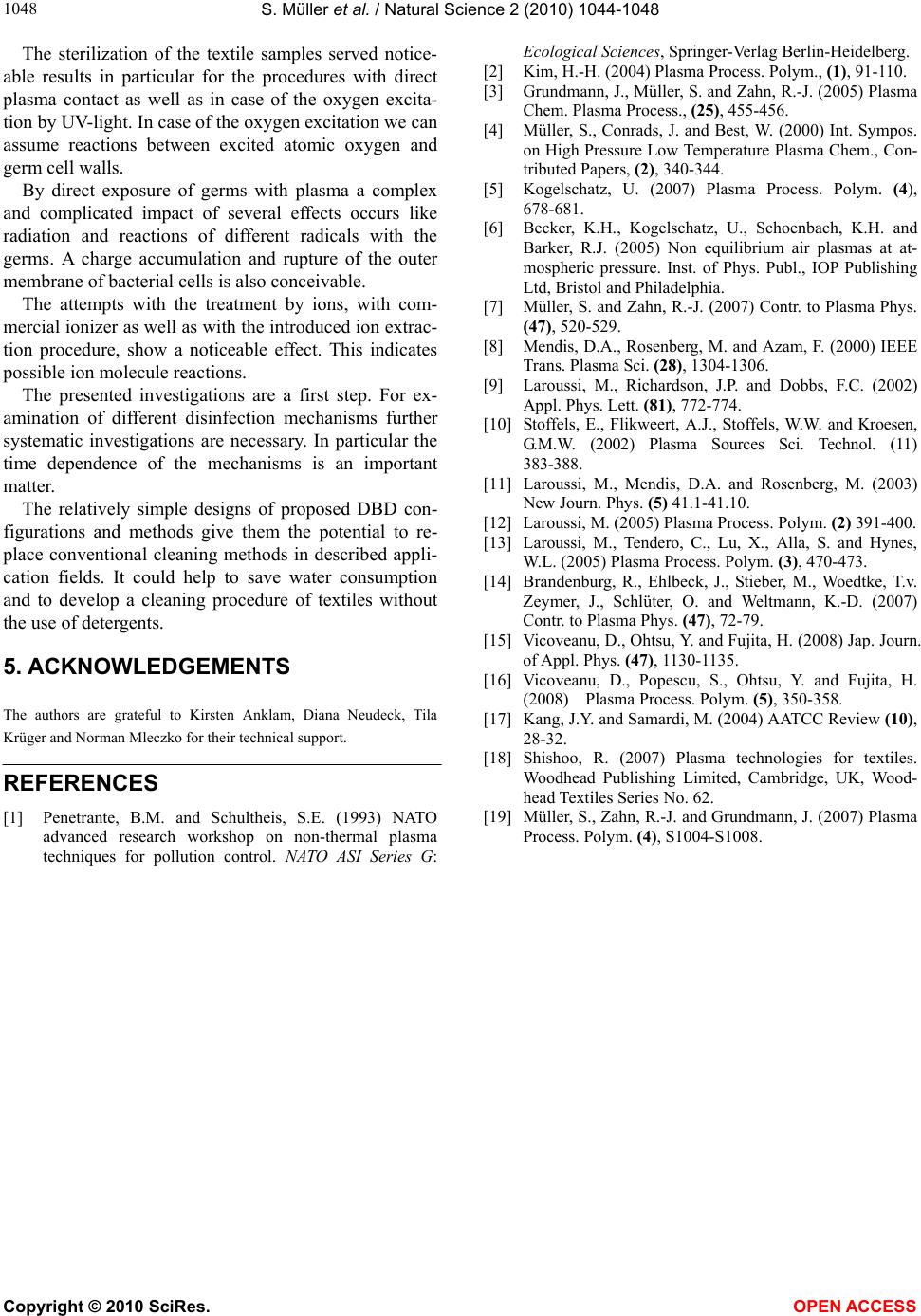
S. Müller et al. / Natural Science 2 (2010) 1044-1048
Copyright © 2010 SciRes. OPEN ACCESS
1048
The sterilization of the textile samples served notice-
able results in particular for the procedures with direct
plasma contact as well as in case of the oxygen excita-
tion by UV-light. In case of the oxygen excitation we can
assume reactions between excited atomic oxygen and
germ cell walls.
By direct exposure of germs with plasma a complex
and complicated impact of several effects occurs like
radiation and reactions of different radicals with the
germs. A charge accumulation and rupture of the outer
membrane of bacterial cells is also conceivable.
The attempts with the treatment by ions, with com-
mercial ionizer as well as with the introduced ion extrac-
tion procedure, show a noticeable effect. This indicates
possible ion molecule reactions.
The presented investigations are a first step. For ex-
amination of different disinfection mechanisms further
systematic investigations are necessary. In particular the
time dependence of the mechanisms is an important
matter.
The relatively simple designs of proposed DBD con-
figurations and methods give them the potential to re-
place conventional cleaning methods in described appli-
cation fields. It could help to save water consumption
and to develop a cleaning procedure of textiles without
the use of detergents.
5. ACKNOWLEDGEMENTS
The authors are grateful to Kirsten Anklam, Diana Neudeck, Tila
Krüger and Norman Mleczko for their technical support.
REFERENCES
[1] Penetrante, B.M. and Schultheis, S.E. (1993) NATO
advanced research workshop on non-thermal plasma
techniques for pollution control. NATO ASI Series G:
Ecological Sciences, Springer-Verlag Berlin-Heidelberg.
[2] Kim, H.-H. (2004) Plasma Process. Polym., (1), 91-110.
[3] Grundmann, J., Müller, S. and Zahn, R.-J. (2005) Plasma
Chem. Plasma Process., (25), 455-456.
[4] Müller, S., Conrads, J. and Best, W. (2000) Int. Sympos.
on High Pressure Low Temperature Plasma Chem., Con-
tributed Papers, (2), 340-344.
[5] Kogelschatz, U. (2007) Plasma Process. Polym. (4),
678-681.
[6] Becker, K.H., Kogelschatz, U., Schoenbach, K.H. and
Barker, R.J. (2005) Non equilibrium air plasmas at at-
mospheric pressure. Inst. of Phys. Publ., IOP Publishing
Ltd, Bristol and Philadelphia.
[7] Müller, S. and Zahn, R.-J. (2007) Contr. to Plasma Phys.
(47), 520-529.
[8] Mendis, D.A., Rosenberg, M. and Azam, F. (2000) IEEE
Trans. Plasma Sci. (28), 1304-1306.
[9] Laroussi, M., Richardson, J.P. and Dobbs, F.C. (2002)
Appl. Phys. Lett. (81), 772-774.
[10] Stoffels, E., Flikweert, A.J., Stoffels, W.W. and Kroesen,
G.M.W. (2002) Plasma Sources Sci. Technol. (11)
383-388.
[11] Laroussi, M., Mendis, D.A. and Rosenberg, M. (2003)
New Journ. Phys. (5) 41.1-41.10.
[12] Laroussi, M. (2005) Plasma Process. Polym. (2) 391-400.
[13] Laroussi, M., Tendero, C., Lu, X., Alla, S. and Hynes,
W.L. (2005) Plasma Process. Polym. (3), 470-473.
[14] Brandenburg, R., Ehlbeck, J., Stieber, M., Woedtke, T.v.
Zeymer, J., Schlüter, O. and Weltmann, K.-D. (2007)
Contr. to Plasma Phys. (47), 72-79.
[15] Vicoveanu, D., Ohtsu, Y. and Fujita, H. (2008) Jap. Journ.
of Appl. Phys. (47), 1130-1135.
[16] Vicoveanu, D., Popescu, S., Ohtsu, Y. and Fujita, H.
(2008) Plasma Process. Polym. (5), 350-358.
[17] Kang, J.Y. and Samardi, M. (2004) AATCC Review (10),
28-32.
[18] Shishoo, R. (2007) Plasma technologies for textiles.
Woodhead Publishing Limited, Cambridge, UK, Wood-
head Textiles Series No. 62.
[19] Müller, S., Zahn, R.-J. and Grundmann, J. (2007) Plasma
Process. Polym. (4), S1004-S1008.